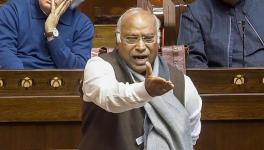The Calamity of Zero Growth in Employment Over Past 5 Years

The unemployment situation is worse today than it has ever been in post-Independence India. There are two distinct elements that have contributed to this situation. One is the fact that the output recovery from the fall caused by the pandemic-linked lockdown has not been accompanied by a comparable employment recovery.
In fact, even though the gross domestic product (GDP) in 2023-24 is estimated to be larger than in 2019-20 by about 18 per cent, employment has shown zero growth over the last five years, according to the Centre for Monitoring the Indian Economy. This fall in the employment-intensity of GDP is because the recovery in output has been much less pronounced in the small and medium scale enterprises than in large-scale ones and the former are much more employment-intensive than the latter.
There is, however, an additional factor. Even by 2019, the unemployment situation had become serious; in fact, the unemployment rate in 2019 was higher than at any time since the inflationary recession that followed in the wake of the first oil-price hike in 1973. This second factor has nothing to do with the pandemic and the uneven recovery from it across sectors; it is associated instead with the immanent tendencies of a neoliberal regime.
What is striking is the fact that even though official statistics show a near-doubling of the average growth rate of GDP between the earlier dirigiste regime and the neoliberal one, the rate of growth of the number of jobs has halved between the two regimes.
The reason for this decline in the rate of growth of employment which has made this rate even lower than the average rate of growth of the labour force over the neoliberal period, lies in the much faster growth in labour productivity which has occurred as a result of the greater openness of the economy. Greater openness has increased competition among producers across countries for the Indian market leading to the introduction of faster technical change; and that typically entails a faster rise in labour productivity.
Added to this has been the unleashing of an agrarian crisis owing to the withdrawal of government support from peasant agriculture; and that in turn has uprooted large numbers of peasants from their traditional calling, forcing them to migrate to cities where they have swollen the number of frustrated job-seekers.
Put differently, the neoliberal regime served to introduce relatively unfettered capitalism into the Indian economy; and unfettered capitalism necessarily generates larger unemployment. The mechanism through which this happens needs to be noted.
Suppose in a given period, the existing capital stock would produce 100 units of output using 100 labourers, but a new technology becomes available that doubles labour productivity; then the 100 units of output will now be produced using only 50 labourers, and the remaining 50 will become unemployed. Precisely because of this rise in unemployment, the wage-rate of the employed labourers will not be any higher than before, so that the total wage bill itself will get halved on account of the rise in labour productivity, thereby raising the share of profits.
This increase in income inequality, or the shift from wages to profits, results in a reduction in consumption (since a larger percentage of wages than of profits is devoted to consumption), and hence in aggregate demand, causing an overproduction crisis that further increases unemployment.
In fact, this is where the well-known English economist David Ricardo had gone wrong. While accepting that the introduction of machinery (i.e., technological change) caused unemployment, he had thought that the higher profits arising from such introduction would raise investment and hence the output and employment growth rate, because of which the decline in employment would only be temporary. Over time, the time-profile of employment after the introduction of machinery would, in fact, overtake the time-profile of employment before the introduction of machinery.
Machinery in other words, while temporarily causing unemployment, is better for employment in the long-run. But Ricardo was a believer in Say’s Law and never took cognizance of any demand problem, which is why he never visualised that higher ex ante profits do not lead to larger investment; on the contrary, greater profits at the expense of wages lead to lower demand and hence lower investment. It follows, therefore, that the initial unemployment caused by technological change gives rise to further, larger, unemployment under unrestricted capitalism.
Indeed, unrestricted capitalism is characterised by perennial mass unemployment, which is far in excess of what the system requires as the minimum level of the reserve army of labour; and technological change is responsible for this as it necessarily creates magnified unemployment.
Technological change under socialism, by contrast, has the effect of reducing the drudgery of work and increasing the leisure-time of the work-force without any reduction in the wage-bill. In the above example for instance, where technological change doubles labour productivity, in a socialist economy it would not give rise to unemployment, but rather to a reduction in working hours by half, while employment remains the same and workers get the same wage-rate as before.
It is not surprising that the only countries in modern times that have experienced full employment (even labour shortage) are the Soviet Union and the old Eastern European socialist countries. All capitalist countries, by contrast, have been invariably saddled with mass unemployment. And neoliberalism, by introducing relatively unrestricted capitalism, had brought India to such a pass, long before the pandemic appeared on the horizon.
It is not a person’s fault if he or she is unemployed; it is the fault of the social arrangement within which that person lives: the social arrangement has proved incapable of providing that person with employment.
The question then arises: what can be a democratic demand on employment? By democratic demand, I mean a demand that does not just ask for socialism (for that would mean a postponement of any relief for the unemployed); what I mean is a demand based on the proximate needs of the unemployed, but not limited by merely what unrestrained capitalism can permit.
The fact that society must take responsibility for unemployment (and the consequent poverty) that afflicts individuals has already been grudgingly conceded by even bourgeois political formations in India, which talk of providing a “basic minimum income” to everyone. But the proposed basic minimum income, apart from being utterly meagre, is also subject to scuttling at any time; what is more, it is in the nature of largesse on the part of the government, a favour that this or that government is doing to the people.
The people, however, are not mendicants; they must get employment (or, in its absence, a full wage, not some paltry unemployment allowance) as a matter of right, in keeping with their dignity as citizens of the country.
Recognition of such a right to employment, which must be universal, constitutionally-guaranteed, and justiciable, on a par with the political and civil rights already guaranteed in the Constitution, would not cost the country more than 3% of GDP at the most. Even an elementary calculation can establish this. If the weighted average wage to be given to an unemployed worker is taken to be Rs 20,000 per month, then, assuming 10% unemployment rate, or roughly four crore unemployed, the requirement of financial resources, if all the unemployed are paid this wage-rate, would be Rs 9.6 lakh crore, which comes to 3.2% of the officially estimated GDP at current prices for 2023-24.
The very handing over of purchasing power to so many unemployed persons, however, will create demand for goods that will generate larger output and hence employment (since the economy is at present demand-constrained), so that only a fraction of the unemployed will need to be paid this wage from the government budget; the rest will get jobs because of the spending by the beneficiaries. The demand on the exchequer, therefore, will be much less than 3.2% of GDP.
Assuming that paying a wage to one person will create a demand for goods that would provide employment to one other additional person, the amount the government needs to spend becomes exactly half of Rs 9.6 lakh crore, i.e., Rs 4.8 lakh crore, which is just 1.6% of GDP. What is more, the additional production of Rs 4.8 lakh crore, will also generate some tax revenue for the government. And if the tax inflow is assumed also to be spent by the government in the same period, then even the 1.6% of GDP does not have to be raised entirely through additional taxation. The requisite additional taxation will be smaller, less certainly than even 1.5% of GDP. This much of financial resources can be raised merely through a 0.8% wealth tax imposed on the wealth of the top 1% of India’s population!
This burden is so small that not providing such a right to employment (through a parliamentary enactment, as in the case of the MGNREGS, in case a constitutional amendment appears difficult) seems a criminal abdication of responsibility.
Get the latest reports & analysis with people's perspective on Protests, movements & deep analytical videos, discussions of the current affairs in your Telegram app. Subscribe to NewsClick's Telegram channel & get Real-Time updates on stories, as they get published on our website.
























